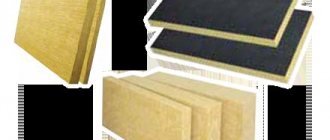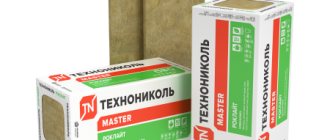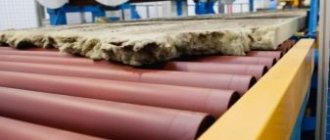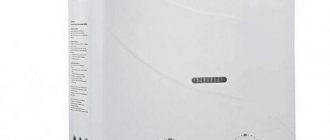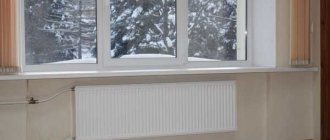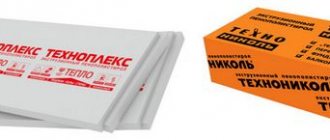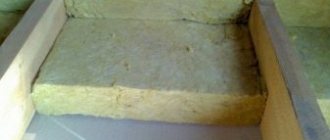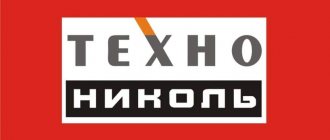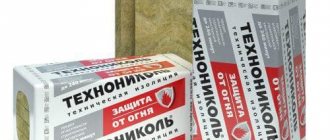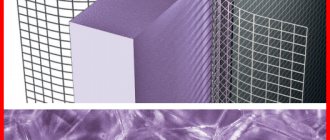In the cartoon about Alyosha Poppovich, he had three paths. Today there is more choice when choosing insulation. However, it is THREE manufacturers that especially stand out: Knauf, Rockwool and our guest today, TechnoNikol insulation products.
The TechnoNikol company was founded in 1993 and today, almost 24 years later, it is the market leader in the field of building materials, in our case thermal insulation. The photo below shows how mineral wool production increased from 2003 to 2015.
Someone will immediately say that in the case of well-known brands you need to overpay for the name, but in an era of crisis this is a very controversial issue. In general, the premium for time-tested quality is worth the nerves and extra effort spent on “fighting” with bad materials made “on the knee”. But, in an era when every manufacturer is fighting for every customer, such markups are becoming a thing of the past.
The company produces materials that are used at very serious facilities:
- Alexandria Theater; Saint Petersburg;
- Torgovy, Nizhny Novgorod;
- Drama Theatre, Omsk;
- St. Petersburg State Technical University, St. Petersburg;
- Trade St. Petersburg;
- Konstantinovsky Palace, St. Petersburg;
- Crimean Bridge, Moscow.
The company produces thermal insulation from two main materials:
- Mineral wool;
- Expanded polystyrene.
Basalt wool, names
Insulation materials made from cotton wool are produced in ten main directions:
- AXI,
- BASALT,
- TECHNOACUSTIC,
- ROCKLIGHT,
- TECHNOBLOCK,
- TECHNOVENT,
- TECHNOLIGHT,
- TECHNORUF,
- TECHNOFAS,
- TECHNOFLOOR.
Of course, each direction represents a material for a specific application. Some types are more or less universal insulation materials. For example, Technofas, as the name suggests, is a slab for facade insulation from TechnoNikol.
Stone wool is produced at factories in Cherkassy, Rostov-on-Don, Zainsk and Chelyabinsk. [flat_ab id=”33"]
Thermal conductivity coefficients
All durable components are gradually heated, and then cooled, in compliance with the intervals, the temperature regime of the internal structure and surface of the material. The thermal insulation qualities of mineral wool are demonstrated by the thermal conductivity coefficient. Its smallest value ensures maximum preservation of thermal conductivity. Often the coefficient values are pre-specified by the manufacturer. The value of the coefficient is determined in laboratory conditions.
Thermal water values vary around 0.032 W/(m*K). The latter indicator is found only in high-quality insulation materials.
Characteristics of stone wool
In general, the features of TechnoNikol stone wool and its technical characteristics are very similar. Basically, when choosing a material, it is worth considering:
- Manufacturer's recommendations;
- Density (hardness);
- Material type.
The manufacturer initially recommends certain types of insulation for specific tasks. For example, Technoacoustic slabs are used to soundproof interior partitions. In the video below, at 6 minutes 31 seconds, the manufacturer recommends Rocklight for attic insulation.
And TechnoNikol recommends Technofas as facade insulation. If there is a need to insulate the foundation, TechnoNikol recommends Technoruf. In general, foundation insulation should be carried out using hard mineral wool slabs.
Density is the second important factor that affects the area of application of cotton wool. There are three main types of wool layout:
- Mats (rolls);
- Soft slabs;
- Rigid slabs;
Mats or rolls are used to insulate the floor in the attic or it can be laid between floors. Insulating the walls of balconies and loggias may require the use of rigid slabs if there is no possibility or desire to use lathing.
Step-by-step installation recommendations
Attic
Insulation of a used attic using TechnoNikol basalt insulation can be done in two ways: before or after laying waterproofing and roofing. As practice shows, the second option is more preferable.
Step 1.
Installation of the rafter system with a pitch of 580-590 mm and laying of wind-moisture-proof film.
Step 2.
Installation of thermal insulation between rafters. Laying is done in a spacer direction from bottom to top. The next layer is installed with a seam spacing that is ½ the length of the heat insulator.
Step 3.
If necessary, a second layer of thermal insulation material is laid, which requires an additional frame.
Step 4.
Laying vapor barrier.
Step 3.
Lining the internal surfaces of the attic.
Unused attic
Step 1.
Completion of all roof installation work.
Step 2.
Installation of a vapor barrier layer using materials that meet the operating conditions.
Step 3.
Installation of counter-lattice with subsequent lining of internal surfaces.
Step 4.
Laying thermal insulation material at random. When creating the second layer, the slabs are laid so that the seams overlap.
Step 5.
Protection from wind and moisture is mounted on top of the heat insulator.
Floors with joists
Step 1.
Insulation begins only after finishing the work on covering the ceiling with wood-based materials or boards.
Step 2.
Laying basalt insulation between the joists.
Step 3.
Installation of a vapor barrier layer using a special film, which is overlapped and fixed with construction tape.
Step 4.
Subfloor installation.
Step 5.
Laying flooring.
Floating floor
Step 1.
Work is being done to level the floor surface.
Step 2.
Installation of a layer of heat and sound insulation using Technoflor basalt insulation.
Step 3.
When installing a cement-sand screed, waterproofing is organized.
Step 4.
Creating a screed.
Step 5.
Installation of decorative flooring.
Suspended floor
Step 1.
Insulation work begins after completion of all measures for the construction of walls and internal partitions.
Step 2.
To install the hangers, mark the walls and ceiling.
Step 3.
Installation of guide profiles.
Step 4.
Installation of hangers.
Step 5.
Installation of ceiling profiles.
Step 6.
Installation of thermal insulation boards Technoacoustic.
Step 7
The surface is sheathed with gypsum board sheets.
Internal partitions
Step 1.
Preparation and cleaning of surfaces on which the insulation will be located.
Step 2.
Marking places for attaching profiles.
Step 3.
Installation of guide profiles.
Step 4.
Installation of racks.
Step 5.
Covering the inner surface with gypsum plasterboard sheets.
Step 6.
Installation of basalt slabs by surprise without additional fastening.
Step 7
Covering the external surface with gypsum plasterboard sheets.
Step 8
Sealing joints of sheet material.
Internal walls
Step 1.
Checking the load-bearing capacity of the wall, cleaning and preparing for installation of the heat insulator.
Step 2.
Fastening the guide profile, which is pre-cut into pieces of the required length.
Step 3.
Installation of rack profile.
Step 4.
Laying the heat insulator against the background. In this case, fastening the material is not required.
Step 5.
Wall cladding with sheet materials.
Step 6.
The joints between the sheets are strengthened with reinforcing tape and puttied.
External brick walls
Step 1.
The bearing capacity of the base is determined.
Step 2.
Marking and installation of the frame.
Step 3.
Installation of basalt insulation by surprise.
Step 4.
Fastening the horizontal frame.
Step 5.
Laying insulation without additional fastening.
Step 6.
Installation of a protective layer of vapor and wind insulation.
Step 7
Finishing work.
Layered brickwork
Step 1.
Before creating a thermal insulation layer, work on preparing the base must be completed and waterproofing must be installed. Insulation and wall construction proceed simultaneously.
Step 2.
Installation of flexible connections using fiberglass.
Step 3.
Installation of a ventilation duct and vents.
Step 4.
Creation of a waterproofing cut-off.
Step 5.
Laying basalt insulation in connection.
Walls lined with siding on a wooden frame
Step 1.
Work on installing thermal insulation begins provided that the frame, roofing, facade cladding and installation of wind and moisture protection are completed.
Step 2.
Attaching the vapor barrier film to the slats.
Step 3.
Installation of thermal insulation boards by surprise.
Step 4.
Inner surface lining.
How much does TechnoNikol mineral wool cost?
The characteristics of TechnoNikol insulation also include cost. In this section we provide the approximate cost of the most popular TechnoNikol stone wool insulation.
| Name | Size | Thickness | Number of slabs per package | Square | Price | Price 1 sq. meters |
| Rocklight | 1200Х600 mm | 50 mm | 12 | 6,91 | 514 rub. | 74 rubles |
| Technoblock PROF | 1200Х600 mm | 80 mm | 6 | 6,91 | 918 rub. | 133 |
| Technolight Optima | 1200Х600 mm | 50 mm | 12 | 8,64 | 603 | 70 |
| Technofas Optima | 1200Х600 mm | 50 mm | 6 | 4,32 | 951 | 220 |
| GreenGuard insulation | 1200Х600 mm | 50 mm | — | 5,76 | 400 | 69 |
Mineral wool thermal insulation cylinders TechnoNikol brand CF 80 measuring 1200 by 20 mm and a diameter of 18 mm cost 50 rubles as of January 2022.
It is easy to notice that materials are available in different price segments. On the TechnoNikol website there is a division into three types of basalt wool: economy, standard and premium. Of course, everything depends not only on financial capabilities, but also on the needs of a particular home.
TechnoACOUSTIC
Technoacoustic thermal insulation boards are non-flammable, sound-absorbing mineral wool boards based on basalt group rocks. The special arrangement of fibers provides high sound-absorbing properties. Recommended for use as a sound absorber in the construction of frame-sheathing partitions and cladding, in the construction of suspended ceilings, as well as in ceilings with a non-loaded installation of insulating material.
The use of TECHNOACUSTIC in the above structures ensures their compliance with building codes and regulations, fire safety requirements and environmental comfort. High physical and mechanical properties ensure reliable operation of the material in vertical structures for more than 50 years.
The use of modern highly effective sound insulation TECHNOAKUSTIK gives higher sound insulation rates and allows you to save on the supporting structure. The main advantages of TECHNOACUSTIC sound insulation are:
- High sound insulation ability;
- Stability of volume and shape, the insulation does not shrink;
- Low water absorption;
- The insulation is resistant to microorganisms and rodents;
- Neutrality in contact with concrete and metal materials;
- Easy installation of insulation, ease of cutting and processing
- Fire safety (NG group)
| Indicator name | Unit measurements | TECHNOACUSTIC | Test method | |
| Compressibility, no more | % | 10 | GOST 17177 | |
| Flammability | degree | NG | GOST 30244 | |
| Thermal conductivity | λ10 | W/m·S | 0,035* | GOST 7076 |
| λ25 | 0,037* | GOST 7076 | ||
| λ A | 0,039* | GOST 7076 SP 23-101-2004 | ||
| λ B | 0,040* | GOST 7076 SP 23-101-2004 | ||
| Vapor permeability, not less | mg/(m h Pa) | 0,3 | GOST 25898 | |
| Humidity by weight, no more | % | 0,5 | GOST 17177 | |
| Water absorption by volume, no more | % | 1,5 | GOST R EN 1609 | |
| Content of organic substances, no more | % | 2,5 | GOST R 52908-2008 (EN 13820-2003) | |
| Density | kg/m3 | 38-45 | GOST R EN 1602 | |
| Sound absorption class for the total thickness of the insulation layer: | 50 mm | NSV | 212 | GOST R – 16297-80 GOST 27296-87 |
| 100 mm | NSV | 211 | ||
| 150 mm | NSV | 211 | ||
| 200 mm | NSV | 111 | ||
Price
RUR/pack
887
from
The concept of thermal conductivity of materials
Any bodies, gaseous, liquid media, when in contact with each other, tend to equalize the temperature of the molecules of which they are composed. The exchange of energy between particles of different materials is called thermal conductivity.
For example:
- in winter, cold street air tends to equalize the indoor temperature;
- why does it take thermal energy from the walls of buildings;
- which is transmitted to them by air heated from the registers of heating devices.
The positive thermal conductivity coefficient of extruded polystyrene foam means energy transfer only in the direction of increasing temperature. Substances with a negative TP coefficient lower the ambient temperature (inert gases used in climate control equipment).
In construction, materials are used that can prevent heat loss and protect the home from the cold. Therefore, the thermal barrier must be continuous so that there are no cold bridges that negate the efforts to insulate the building.
Fig.2 Comparison of thermal conductivity of structural and thermal insulation materials
Rolled waterproofing for foundations
Foundation waterproofing materials, characterized by high heat resistance and excellent flexibility at low temperatures, are used to protect the underground and lateral parts of the foundation, as well as to create a barrier between load-bearing walls and the foundation.
These company products are represented by a number of types, differing in their specialization. Thus, the Technoelast Barrier material, made in the form of a polymer film and having high levels of flexibility and elasticity, can be used to insulate the foundation from both the outside and the inside. "Technoelast Barrier Light", the outer layer of which is made of non-woven fabric, not only protects against moisture, but also simplifies the installation of ceramic tiles. A material such as “Technoelast EPP” is able to withstand any influence of a humid environment, even the most extreme, due to which it is successfully used in areas characterized by high groundwater levels.
PIR thermal insulation boards
PIR boards are an innovative type of thermal insulation from TechnoNIKOL. The technical characteristics of these slabs allow them to be successfully used for insulating flat roofs. Due to the closed cell structure and coating with aluminum foil, the materials are characterized by high fire resistance, water resistance, durability, resistance to repeated physical stress and a very low thermal conductivity coefficient. The thermal insulator does not support combustion, which allows PIR boards to protect other layers in the system from fire. They also serve as a waterproofing material.
Brands, composition and application of Technoelast
Below we discuss in detail the technical characteristics and scope of use of various modifications of the roll material.
Technoelast HPP
Technoelast XPP can be used as waterproofing of construction sites and vapor barrier of soft roofs. The material retains its physical, technical and operational characteristics over a wide temperature range.
The HPP modification is a compressed fiberglass coated on both sides with modified bitumen with SBS polymer additives. The protective film, which serves as an indicator during fusing, prevents the web from sticking together in the roll.
Technoelast EPP
The reinforcing basis for Technoelast EPP is high-quality polyester. As a protective coating, a low-melting polymer film with a heating indicator is applied on both sides.
The material is used as the bottom layer of waterproofing of flat bitumen roofs of new buildings, because It is characterized by sufficient strength and elasticity, which allows it to compensate for shrinkage deformations. In addition, the EPP modification is used for waterproofing foundations, plinths, basements, etc.
Technoelast TKP
This modification of Technoelast is the most common. The basis is fiberglass, characterized by high strength characteristics and affordable cost. Coarse-grained mineral coating is used as a decorative and protective layer, which reliably protects the material from ultraviolet radiation, mechanical damage, chemical, biological and atmospheric influences.
The material is used for fusing the top layer of two-layer waterproofing of flat roofs of established buildings, as well as as the only layer of waterproofing of flat roofs during major renovations
Technoelast EKP
A reinforcing layer of polyester fiber allows the material to deform without changing the strength characteristics, integrity of the waterproofing layer and the protective and decorative layer of coarse shale chips.
These unique properties make it possible to use Technoelast EKP as the top layer of two-layer waterproofing for flat roofs of new buildings of any size. In addition, the material can be used as a single layer for major repairs and waterproofing of flat roofs
Technoelast Acoustic
It is used as a hydro- and sound-proofing layer in building structures, including when constructing floating floors. Significantly reduces impact noise exposure (by 21–26 dB).
The basis of Technoelast “Acoustic” is soundproof fiberglass, onto which a modified bitumen-polymer layer is applied. The canvases are laid end-to-end (the soundproofing layer is on the base side), taking into account the height of the finishing coating, and then secured with tape.
Solo
Technoelast “Solo” has a wide range of colors. Coarse-grained mineral coating is used as a protective and decorative layer; the lower part is a non-woven fabric. Used as waterproofing and when installing a single-layer roofing carpet. The material is indispensable in cases where simple mechanical fixation or laying on a layer of mastic is required.
Important! Can be fixed to the base using partial fusion. It has improved fire-fighting characteristics and is a moderately flammable material that practically does not spread flame.
Mini
Technoelast Mini EPP differs from its standard counterpart in having a smaller web width. To modify the bitumen-polymer binder, special SBS polymers and functional additives are introduced into it. The material is characterized by versatility, strength, elasticity and durability. It is used as a vapor barrier layer for fused roofs and waterproofing of various building structures.
Technoelast S
The reinforcing basis of Technoelast “S” EMS is a high-strength biostable polyester fabric impregnated on both sides with a bitumen-polymer binder composition. A low-melting polymer film is used as a coating.
Prime
What distinguishes Technoelast Prime EMM from other modifications is the possibility of without fire installation. The reinforcing base is a high-quality polyester fabric, onto which a bitumen-polymer binder composition is applied on both sides, which includes fillers, modified styrene-butadiene thermoplastic elastomer and other functional additives.
Decor
Technoelast "Decor" is produced by applying bitumen on a reinforcing base (cross-reinforced polyester) on both sides - a polymer binder composition consisting of bitumen, SBS (styrene-butadiene-styrene) polymer modifier and mineral fillers (talc, dolomite, etc.). Both sides of the canvas have a protective coating: a coarse-grained basalt coating on top and a polymer fusible film on the welded side.
Titanium
Technoelast "Titan" is produced by applying a binder bitumen-polymer mixture consisting of bitumen, APP (atactic polypropylene), IPP (isotactic polypropylene) polymer modifier and mineral fillers (talc, dolomite, etc.) on a non-woven polyester fabric on both sides, followed by application protective layers on both sides of the fabric. Coarse-grained, fine-grained (sand) coatings and polymer coatings can be used as protective layers.
Thermo
Technoelast "Thermo" is a multifunctional, APP-modified bitumen-polymer built-up roofing and waterproofing material of increased reliability. It is used for roofing buildings and structures, waterproofing foundations, bridges, tunnels and other building structures that require high reliability of waterproofing.
Green
Technoelast "Green" is resistant to damage by plant roots. It has chemical and mechanical protection against germination. The material is produced by double-sided impregnation of a polyester base with a bitumen-polymer binder consisting of bitumen, SBS (styrene-butadiene-styrene) polymer modifier, mineral filler (talc, dolomite, etc.) and anti-root additives. After this, protective coatings are applied to both sides of the canvas. Coarse-grained, fine-grained powders and polymer films are used as protective coatings.
